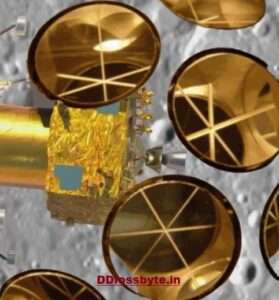The Chandrayaan-3 mission, a collaborative effort between the Indian Space Research Organisation (ISRO) and NASA, is gearing up to revolutionize lunar exploration.

One of the mission’s standout features is the Laser Retroreflector Array (LRA), a payload that promises to contribute significantly to the scientific endeavors of future lunar missions.
Chandrayaan-3: A Joint Mission
Chandrayaan-3 represents a remarkable collaboration between ISRO and NASA, combining their expertise and resources to explore the Moon’s mysteries. Following the partial success of Chandrayaan-2, the decision to embark on Chandrayaan-3 was made to further lunar exploration.
The Role of the LRA
At the heart of Chandrayaan-3’s scientific payload is the Laser Retroreflector Array (LRA). This instrument, developed by NASA, is designed to be a long-term asset on the lunar surface. Its primary function is to reflect laser beams sent from Earth or lunar orbiters back to their source with exceptional precision.
How the LRA Works
The LRA essentially consists of a series of corner-cube prisms, which are exceptionally effective at reflecting light or laser beams. These prisms are strategically arranged to ensure that incoming laser beams are accurately redirected toward their source. By analyzing the time it takes for the laser beams to return, scientists can precisely calculate the distance between Earth or lunar orbiters and the LRA on the Moon’s surface.

Benefits for Future Missions
The LRA on Chandrayaan-3 is expected to serve several critical purposes for future lunar missions:
- Precise Positioning: By accurately measuring the distance between Earth or lunar orbiters and the LRA, future missions can improve their navigation and positioning systems. This will be invaluable for landing missions and scientific observations.
- Seismology Studies: The LRA will help scientists monitor lunar seismic activity. Any disturbances on the Moon’s surface can be detected by analyzing the reflections of laser beams. This data is vital for understanding the Moon’s geology and potential lunar quakes.
- Gravitational Studies: Lunar missions can also utilize the LRA to enhance their studies of the Moon’s gravitational field. Precise measurements of the Moon’s gravitational anomalies can provide valuable insights into its interior composition.

Among the payloads activated by the Indian Space Research Organization (ISRO) are the Radio Anatomy of Moon Bound Hypersensitive ionosphere and Atmosphere (RAMBHA), Chandra’s Surface Thermo physical Experiment (ChaSTE), and the Instrument for Lunar Seismic Activity (ILSA). In contrast, the LRA stands out as an international collaborative instrument designed by NASA.
Retroreflectors, a hallmark of the LRA, exhibit the remarkable property of reflecting incident light directly back to its source. These retroreflectors can be effectively tracked by orbiting laser altimeters or lidar systems, even from distances spanning several hundred kilometers.
To prevent interference with the lander’s optical equipment, such as cameras and spectrometers, the LRA’s ranging operations have been postponed until after the conclusion of the Chandrayaan-3 mission. This decision is in line with the recommendations of Xiaoli Sun, the principal investigator of the LRA, and other members of the LRA team.
Moreover, the deployment of multiple LRAs on the lunar surface can establish fiducial markers and form a geodetic network, an invaluable asset for planning precise landings in future lunar missions. Currently, NASA’s Lunar Reconnaissance Orbiter (LRO) is the sole orbiter equipped to perform laser ranging through its laser altimeter, known as LOLA.

The LRA is a set of 11 corner-cube retroreflectors that can be used to precisely determine the location of the lander on the lunar surface. This information can be used by future missions to accurately measure the distance between the Earth and the Moon, as well as to study the lunar gravity field.
The LRA is expected to continue to work for many years to come, providing valuable data for future lunar missions.

In addition to the LRA, the Chandrayaan-3 lander also carried three other payloads:
- The Terrain Mapping Camera (TMC) will map the lunar surface in high resolution.
- The Alpha Particle X-ray Spectrometer (APXS) will analyze the chemical composition of the lunar surface.
- The Moon Impact Probe (MIP) will impact the lunar surface and study the resulting ejecta.


The inclusion of the Laser Retroreflector Array (LRA) as part of Chandrayaan-3’s payload is a testament to the collaborative spirit of international space agencies. Its potential contributions to future lunar missions, both in terms of navigation and scientific research, make it a valuable addition to humanity’s ongoing exploration of the Moon. As Chandrayaan-3 continues its journey towards the Moon, the LRA stands ready to play a crucial role in advancing our understanding of Earth’s celestial neighbor.
